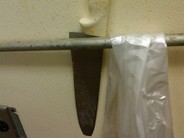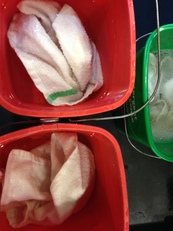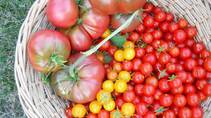05/31/2015
Vol. 19, Issue 3
Food Digest is a quarterly newsletter written by inspectors from your local health department to support and educate Hennepin County food facility owners and managers about food safety as recommended by Minnesota Food Code 4626.
Selling homemade food at a community event or farmers' market
Homemade
food that is not potentially hazardous (i.e. maple syrup, fruit pies, cakes,
cookies, breads) can be sold at community events or farmers' markets without a license if:
-Gross receipts from
the food items do not go over $5,000.00 in one calendar year;
and
-The person selling
these foods must post a visible sign stating: "These products are homemade
and not subject to health inspection";
and
-All products must
be labeled to include the name and address of the person preparing and selling
the items.
More information
regarding Farmers' Markets can be found on the Minnesota Department of Agriculture's website.

We welcome comments or ideas about our newsletter.
Amy Zagar
612-543-5267
Hannah Marschinke
612-543-5255
|

A quick overview of proper cleaning and
sanitizing procedures
A fomite (aka. any surface in your kitchen) can be a breeding
ground for microbes if it is not cleaned routinely. Think about all the surface
areas in your kitchen: cutting boards, knives, food prep tables, utensils,
handles on coolers, etc. These surfaces should be cleaned and sanitized
frequently to avoid risky situations. (Picture- dirty knife stored improperly)
What is the risk? Food debris and residue left on surfaces
provide an abundance of nutrients for disease-causing bacteria to thrive. As
bacteria multiply exponentially, they can quickly and easily contaminate your
hands, gloves, and other food and work surfaces. Routine cleaning and
sanitizing is your greatest defense. The best times to clean and sanitize are:
after use, at timed intervals, or anytime surfaces are visibly soiled.
Here are some cleaning and sanitizing tips (MN Food Code 4626):
1. Clean and sanitize surfaces between
cutting different types of raw meat, between working with raw meats and
ready-to-eat foods, and anytime contamination or visible food debris is
present.
2. If utensils or equipment (which is
not under temperature control) are used continuously with potentially hazardous
food, they must be washed, rinsed, and sanitized at least every four hours.
3. Non-food contact surfaces— such as cooking
or baking equipment, and the interior cavity of microwaves — must be cleaned
every 24 hours.
4. Non-food contact surfaces of refrigerators,
shelves, and other equipment must be cleaned frequently enough to prevent
accumulation of dust, dirt, food residue, and other debris.
Take home note: Clean and sanitize all surfaces
frequently!
|

Wiping
cloths and microbes
Wiping cloths can also become an environment where bacteria
flourish. Some tips:
1. Store wet wiping cloths in an EPA-approved
sanitizing solution. Common examples of approved wiping cloth sanitizers are
chlorine (50-100 PPM) and quaternary ammonia (200-400 PPM).
2. Keep chemical sanitizing solutions at
their proper concentration and free from food debris and visible soil.
3. Moist cloths used with raw animal
foods must be kept in a separate sanitizing solution.
4. To verify that a sanitizer is at a proper
concentration, use a test kit to test it periodically. Fresh sanitizer should be
replaced at least every four hours.
5. Always label sanitizer spray bottles
and sanitizer buckets with the common name or “sanitizer.”
6. When purchasing a sanitizer, make
sure the product has an EPA registration number and is approved for food
contact surface use.
Take
home note: Keep your wiping cloths stored correctly and make sure your
sanitizer is EPA-approved and is at a proper concentration.
|

Spring is finally here. The flowers are blooming and local
farmers are hopeful for an abundant crop. Because farmers markets are popping
up in nearly every city, we often get questions like:
Can food facilities like restaurants, grocery stores, and school
lunch programs legally buy or accept donated produce from a farmers market or
directly from a grower and serve it to clients, students, or customers?
The answer is “Yes.” In fact, this trend has been on the rise
since 2003.
The Minnesota Department of Agriculture, Minnesota Department of
Health, and the University of Minnesota teamed up and produced an informative fact
sheet that explains how food facilities can use locally grown produce
safely and legally.
Take
home note: You CAN purchase and serve locally grown food from an approved source. For more information
read the fact sheet.
|

Is your
kitchen bright enough?
A well-lit work space is an essential component of kitchen and
storage areas. Food facilities licensed with Hennepin County must follow
the lighting requirements noted in Hennepin
County Ordinance Three:
Food preparation areas must be lit to 70 foot-candles.
Storage areas including dry storage areas, walk-in coolers, and
walk-in freezers must be 30 foot-candles.
Facilities licensed under Minnesota Department of Agriculture
are required to provide 50 foot-candles for food preparation areas and 20 foot-candles
for all storage areas (including dry storage areas, walk-in coolers, and
walk-in freezers).
|
Visit www.hennepin.us/envhealth for information on:
- General environmental health
- Basic food safety classes
- Temporary food stand licensing
- Food license information, categories, and fee schedule
- New construction or remodling application
Radon information and
test kits
www.hennepin.us/radon
Septic System
requirements and procedures
www.hennepin.us/septic
Body Art Licensing
information (tattooing and piercing)
www.hennepin.us/bodyart
Beaches in Hennepin
County
www.hennepin.us/beaches
Visit www.hennepin.us/envhealth to subscribe to our e-newsletter.
|